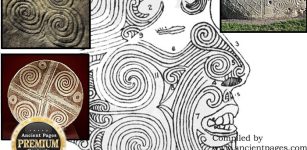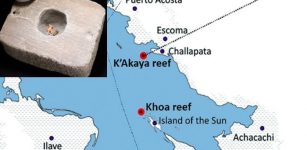On This Day In History: Mesoamerican Long Count Calendar Begins – On August 11, 3114 B.C
AncientPages.com - On August 11, 3114 BC, the Mesoamerican Long Count calendar began. It was in use by several pre-Columbian Mesoamerican civilizations, especially the Maya.
According to Maya theology, the world was created on a date modern people would write as "August 11, 3114 BC."
Mayas calendar copy - Χαράλαμπος Γκούβας (Harrygouvas) - CC BY-SA 3.0
On this day, Raised-up-Sky-Lord caused three stones to be set by associated gods at Lying-Down-Sky, First-Three-Stone-Place. The setting of the three stones centered on the cosmos, which allowed the sky to be raised, revealing the Sun. Because the sky still lay on the primordial sea, it was black.
The Maya Long Count Calendar was mainly designed to keep track of very long intervals, and it is the most complex calendar system ever developed by people anywhere.
Long Count Calendar identifies a day by counting the days passed since a mythical creation date.
The Long Count Calendar resembles the odometer in a car. It's a modified base-20 system in which rotating digits represent powers of 20 days. Because the digits rotate, the calendar can "roll over" and repeat itself. Time according to the Maya is not linear but cyclical.
The Maya did not invent the calendar. It was used by most cultures in pre-Columbian Central America, including the Maya, from around 2000 BCE to the 16th century. The Mayan civilization developed the calendar further, and it's still in use in some Maya communities today.
The two most widely used calendars in pre-Columbian Mesoamerica were the 260-day Tzolkin and the 365-day Haab'. The equivalent Aztec calendars are known in Nahuatl as the tonalpohualli and Xiuhpohualli.
The Long Count Calendar dates can often be found on ancient monuments. The earliest known Long Count date, carved in 31 BC, was found at the Olmec site of Tres Zapotes. The earliest known Maya long count was recorded in 32 AD at the site of Chiapa de Corzo in the Highlands of Chiapas, Mexico.
On this day, Raised-up-Sky-Lord caused three stones to be set by associated gods at Lying-Down-Sky, First-Three-Stone-Place. Because the sky still lay on the primordial sea, it was black. The setting of the three stones centered the cosmos, which allowed the sky to be raised, revealing the Sun.
The Maya Long Count Calendar was especially designed to keep track of very long intervals, and it is the most complex calendar system ever developed by people anywhere.
Long Count Calendar identifies a day by counting the days passed since a mythical creation date.
Written using modern typography, the Long Count Calendar resembles the odometer in a car. It's a modified base-20 system in which rotating digits represent powers of 20 days. Because the digits rotate, the calendar can "roll over" and repeat itself. According to the Maya, time is not linear but cyclical.
The Maya did not invent the calendar. It was used by most cultures in pre-Columbian Central America, including the Maya, from around 2000 BCE to the 16th century. The Mayan civilization developed the calendar further, and it's still in use in some Maya communities today.
The two most widely used calendars in pre-Columbian Mesoamerica were the 260-day Tzolk'in and the 365-day Haab'. The equivalent Aztec calendars are known in Nahuatl as the Tonalpohualli and Xiuhpohualli.
The Long Count Calendar dates can often be found on ancient monuments. The earliest known date, carved in 31 BC, was found at the Olmec site of Tres Zapotes. The earliest known Maya long count was recorded in 32 AD at the site of Chiapa de Corzo in the Highlands of Chiapas, Mexico.
AncientPages.com





















